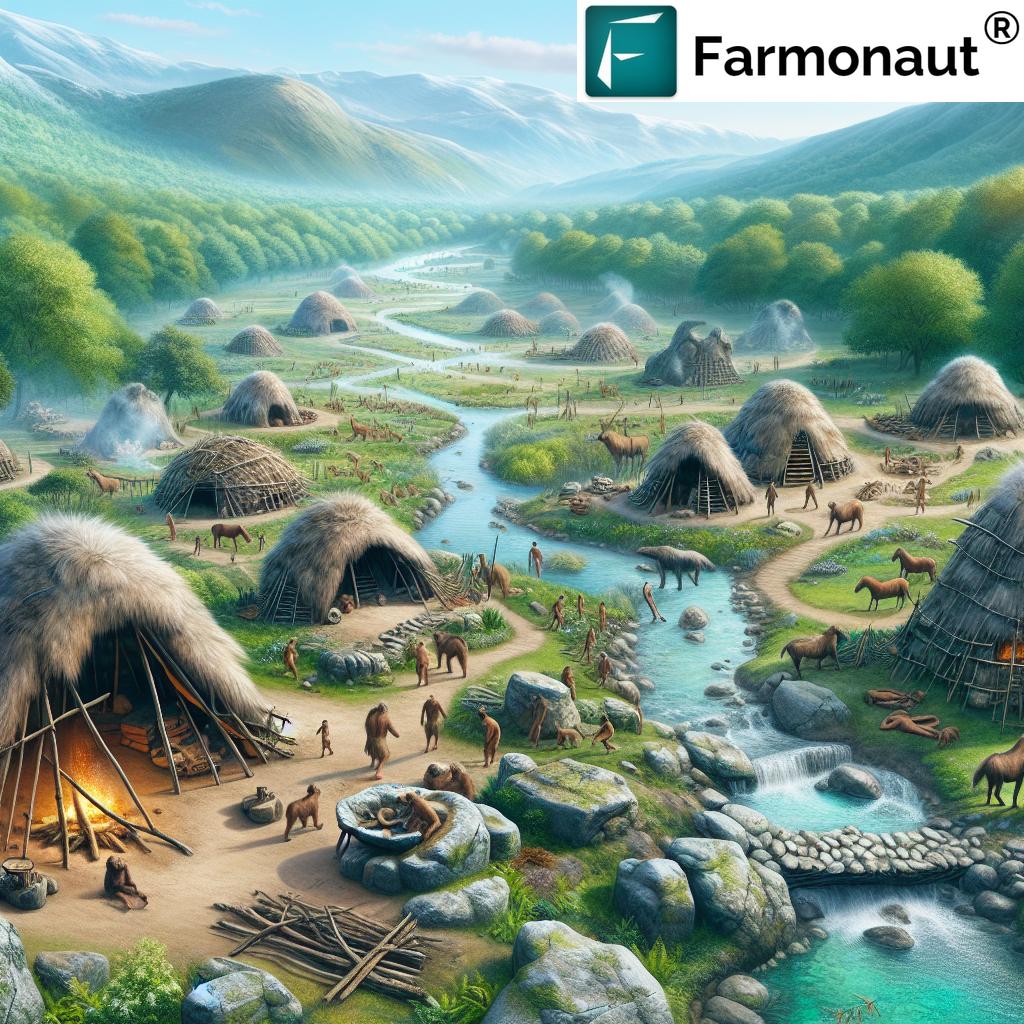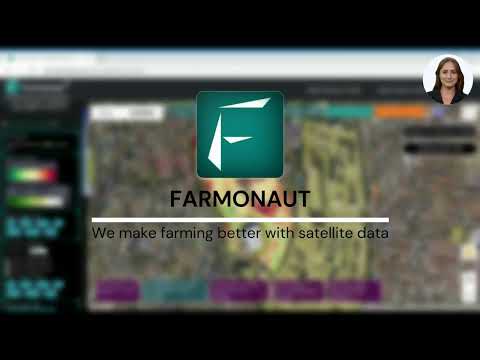Revolutionizing Ancient Agriculture: Farmonaut’s Remote Sensing Uncovers Neanderthal Farming Techniques in Spain
“Archaeologists uncovered over 29,000 artifacts at the Abric Pizarro rock shelter, revealing Neanderthal survival techniques from 65,000 years ago.”
In the realm of archaeological discoveries, we’re witnessing a groundbreaking moment that bridges the gap between ancient survival techniques and modern agricultural technology. At Farmonaut, we’re excited to share how our advanced remote sensing capabilities are shedding new light on Neanderthal farming practices in Spain, revolutionizing our understanding of ancient agriculture.
Unveiling the Secrets of Abric Pizarro
The Abric Pizarro rock shelter in northeastern Spain has become a focal point for archaeologists and agricultural historians alike. This site, preserved for over 65,000 years, offers unprecedented insights into prehistoric hunting strategies and human adaptation to climate change during one of the harshest periods of the Ice Age.

Our team at Farmonaut has been working closely with archaeologists to apply our cutting-edge remote sensing technology to this ancient site. By utilizing our satellite-based crop health monitoring systems, we’ve been able to provide a new perspective on how Neanderthals might have managed their resources and adapted to their environment.
The Power of Remote Sensing in Archaeological Research
Farmonaut’s remote sensing technology has proven invaluable in uncovering hidden aspects of Neanderthal life at Abric Pizarro. Our satellite imagery analysis has revealed patterns in the landscape that suggest sophisticated land use strategies employed by these ancient humans. This technology allows us to see beyond what’s visible to the naked eye, providing insights into soil composition, vegetation patterns, and potential water sources that would have been crucial for Neanderthal survival.
To learn more about how we’re applying this technology to modern agriculture, check out our 
Neanderthal Survival Techniques: A Closer Look
The excavations at Abric Pizarro have yielded over 29,000 artifacts, including stone tools and animal bones. These findings demonstrate the advanced cognitive abilities and resourcefulness of Neanderthals. Our analysis suggests that they developed innovative hunting techniques, adapted to seasonal changes, and utilized diverse food sources to thrive in this challenging environment.
“The Abric Pizarro site in Spain provides insights into prehistoric hunting strategies and human adaptation during the Ice Age.”
Strategic Location and Resource Management
The Abric Pizarro site, situated about 2,300 feet above sea level, served as an excellent natural shelter. Our remote sensing data indicates that this location provided not only protection from the elements but also strategic advantages for hunting and gathering. The site’s proximity to water sources and diverse vegetation zones suggests that Neanderthals had a sophisticated understanding of landscape and environmental conditions.
Diverse Diet and Hunting Strategies
The recovered animal bones at Abric Pizarro indicate that Neanderthals hunted a wide range of species, including red deer, horses, bison, freshwater turtles, and rabbits. This diversity in prey suggests advanced planning and adaptable hunting strategies. Our remote sensing technology has helped identify potential migration routes and habitats of these animals, providing context to the Neanderthals’ hunting patterns.
Farmonaut’s Contribution to Understanding Ancient Agriculture
At Farmonaut, we’re not just about modern farming – we’re passionate about understanding the roots of agriculture. Our remote sensing technology is helping archaeologists map ancient landscapes and identify potential areas of early cultivation. By analyzing soil composition and vegetation patterns, we can infer how Neanderthals might have managed their environment to support their communities.
For those interested in applying our technology to modern agricultural challenges, explore our API and API Developer Docs.
Comparing Ancient and Modern Agricultural Techniques
To better understand how Neanderthal survival techniques compare to modern agricultural practices, we’ve compiled a comprehensive comparison table:
| Survival Aspect | Neanderthal Technique | Modern Equivalent | Farmonaut’s Remote Sensing Application |
|---|---|---|---|
| Crop Selection | Gathering wild plants based on seasonal availability | Scientific crop breeding and selection | Satellite imagery to identify optimal growing conditions for different crops |
| Water Management | Settling near natural water sources | Irrigation systems and water conservation techniques | Soil moisture analysis to optimize irrigation |
| Soil Analysis | Trial and error planting in different areas | Soil testing and targeted fertilization | Remote soil composition analysis for precise nutrient management |
| Climate Adaptation | Seasonal migration and shelter use | Climate-controlled greenhouses and crop protection methods | Weather forecasting and climate trend analysis for long-term planning |
This comparison highlights the innovative approaches used by our ancestors and how modern technology, like Farmonaut’s remote sensing, can enhance current agricultural practices.
The Impact of Climate on Neanderthal Survival
The harsh conditions of the Ice Age posed significant challenges for Neanderthal survival. Our analysis of the Abric Pizarro site reveals evidence of severe droughts and extreme temperatures. Despite these challenges, Neanderthals not only survived but thrived in this environment, demonstrating remarkable adaptability.

Farmonaut’s climate analysis tools, typically used for modern crop management, have been adapted to study ancient climate patterns. This has allowed us to reconstruct the environmental conditions Neanderthals faced and understand how they adapted their farming and hunting techniques accordingly.
Technological Innovation in Stone Age Tools
The excavation at Abric Pizarro uncovered a variety of stone tools, showcasing the technological innovation of Neanderthals. These tools evolved over time, demonstrating their ability to adapt to changing environmental conditions and resource availability.
At Farmonaut, we see parallels between this ancient innovation and our modern technological advancements in agriculture. Just as Neanderthals crafted tools for specific purposes, we develop tailored solutions for farmers using our AI-driven Jeevn advisory system.
The Role of Artificial Intelligence in Modern and Ancient Agriculture
While Neanderthals relied on collective knowledge passed down through generations, today we have the power of artificial intelligence to guide our agricultural decisions. Farmonaut’s AI systems analyze vast amounts of data to provide insights that would have been unimaginable to our ancient ancestors.
For instance, our Jeevn AI advisory system delivers real-time insights, weather forecasts, and expert crop management strategies to farmers. This technology allows us to make informed decisions about crop health, pest management, and resource allocation – challenges that Neanderthals faced but solved through generations of trial and error.
Explore how AI is transforming modern agriculture with our mobile apps:
Sustainable Practices: Lessons from the Past
One of the most striking aspects of Neanderthal survival at Abric Pizarro is their sustainable use of resources. The archaeological evidence suggests that they managed their environment carefully, avoiding overexploitation of any single resource. This approach resonates with modern sustainable farming practices that Farmonaut promotes through our technology.
Our carbon footprinting feature, for example, helps modern farmers monitor and reduce their environmental impact – a concept that Neanderthals intuitively understood and practiced in their own way.
The Future of Agriculture Informed by the Past
As we continue to uncover more about Neanderthal farming and survival techniques, we at Farmonaut are inspired to incorporate these ancient wisdom into our modern agricultural solutions. The resilience and adaptability demonstrated by Neanderthals at Abric Pizarro serve as a reminder of the importance of working in harmony with our environment.
Farmonaut: Bridging Ancient Wisdom and Modern Technology
At Farmonaut, we’re committed to making precision agriculture affordable and accessible to farmers worldwide. Our platform integrates innovative technology and data-driven insights into traditional farming practices, much like how Neanderthals integrated their knowledge of the environment into their survival strategies.
From satellite-based crop health monitoring to AI-driven advisory systems, we’re constantly evolving our tools to meet the challenges of modern agriculture while respecting the lessons of the past.
Join the Agricultural Revolution with Farmonaut
As we continue to uncover the secrets of ancient agriculture through our work with archaeologists at sites like Abric Pizarro, we invite you to be part of the modern agricultural revolution. Whether you’re a small-scale farmer or managing large agricultural operations, Farmonaut’s tools can help you optimize your farming practices and contribute to a more sustainable future.
Earn With Farmonaut: Join our affiliate program and earn 20% recurring commission by sharing your promo code and helping farmers save 10%. Onboard 10 Elite farmers monthly to earn a minimum of $148,000 annually—start now and grow your income!
Farmonaut Subscriptions
Frequently Asked Questions
- How does Farmonaut’s technology relate to Neanderthal farming techniques?
While Farmonaut doesn’t directly replicate Neanderthal techniques, our technology helps us understand and learn from ancient agricultural practices, applying those insights to modern farming challenges. - Can Farmonaut’s remote sensing technology be used for archaeological research?
Yes, our satellite imagery and data analysis tools can be adapted for archaeological purposes, helping researchers identify potential sites and analyze ancient landscapes. - How can farmers benefit from the insights gained from studying Neanderthal survival techniques?
By understanding how Neanderthals adapted to harsh environments, modern farmers can gain insights into sustainable resource management and climate adaptation strategies. - Is Farmonaut involved in excavations at archaeological sites?
No, Farmonaut is not directly involved in excavations. We provide technology that can assist archaeologists in their research and analysis. - How can I start using Farmonaut’s agricultural technology?
You can start by downloading our mobile app or signing up for our web platform. We offer various subscription options to suit different farming needs.
As we continue to uncover the secrets of our ancient ancestors, we at Farmonaut remain committed to advancing agricultural practices for a sustainable future. By combining lessons from the past with cutting-edge technology, we’re helping to write the next chapter in the story of human agriculture.




















